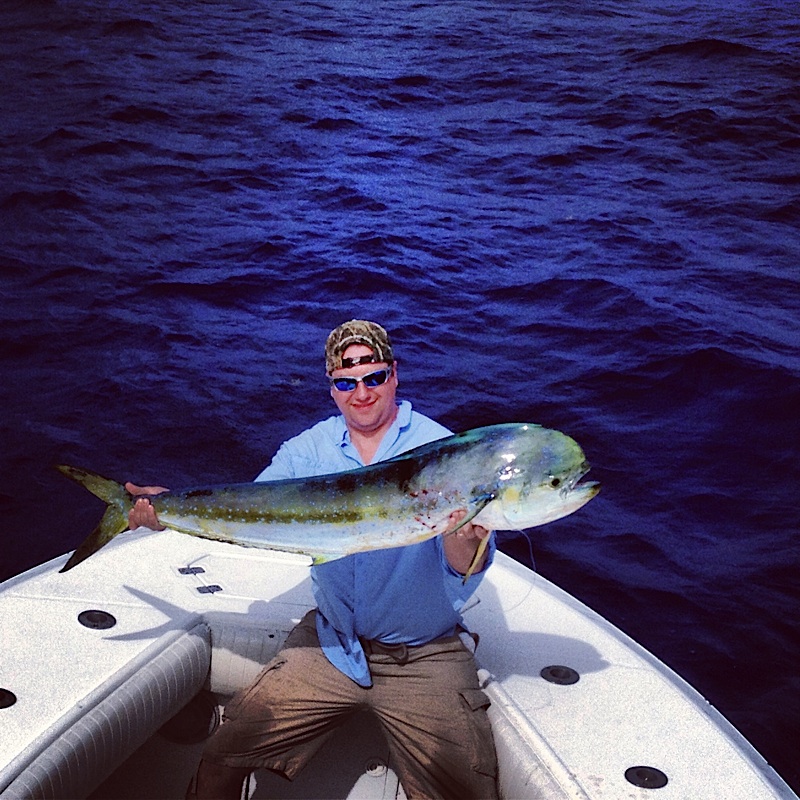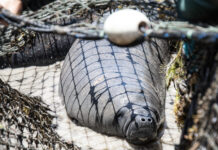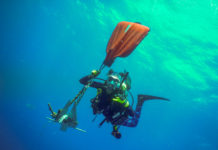If you haven’t noticed, it rained a bit in the Keys during early June. Even though I try to stay positive and say, “Hey, a little rain never hurt anybody,” it does start to wear on you after awhile. Consistently overcast weather doesn’t necessarily make fishing easier either. When there’s nothing but cloudy conditions, water visibility is low and it’s hard, even for the birds, to spot fish. On days like that, I like to keep lines in the water as much as possible. Trolling isn’t my method of choice to catch fish, but fishing options are limited when the sun hasn’t been out for days.
When I troll I normally run offshore until I find something promising, such as scattered grass or a weed line. I’ll work the area with trolling ballyhoo and lures for about 30 to 45 minutes, trying to get something to bite. If nothing takes the bait, I’ll run again until I find the next promising spot and put the lines back out. I’ll keep repeating these steps until I come across an area with some hungry fish.
Trolling ballyhoo for a long period of time can really take a toll on the bait, though. If you choose to troll, you need to constantly check your bait. If it’s looking a little worn-out, don’t hesitate to switch it out for a fresh, firm ‘hoo. I’ve gone through a few dozen ballyhoo in one charter before. Remember, you want to make sure that bait is as appealing as possible. If you don’t have dozens of ballyhoo to go through, put an artificial skirt or small lure in front of the bait as you troll it. This will protect the bait-fish as you drag it through the water and help it last longer.
While it’s easy to get gloomy with this weather, there are a few bright spots when it comes to fishing around storms. Summer storms normally keep anglers off the water and that gives the fish a break. They’re generally more willing to take a bait when it’s been several hours since they’ve come across one. Also, the dark water lets fishermen get away with using heavier leader, which is a big advantage when trying to pull those big black groupers out of the rocks.
If the weather really puts a damper on your fishing plans and you can’t get out on the water, take that opportunity to do some much needed rod and reel maintenance. If you are not comfortable doing your own repairs, you can take your rods and reels to most local tackle shops and they can either fix it there for you, or recommend a local who can. I’m not the greatest at fixing my rods, so I often take them to a local shop whenever I need a guide or tip replaced.
I am handy at maintaining my reels, though. I like to take my reels apart and do all their cleaning and repairs on the coffee table in my living room, much to the dismay of my wife. Normally, the most common reel problem is a “sticky reel.” This is when a reel spins fine when there is no tension on the line, but when a fish is on the other end, the handle becomes very difficult to turn. To clean a sticky reel, take it apart and clean all the bearings with W-D 40 and a toothbrush. Put new grease on all the parts, and then put the whole thing back together. While you’re cleaning your reel, keep an eye out for parts that needed replacing, like a worn out or corroded bearing. Local tackle shops should have any replacement parts you may need.
Another maintenance step to perform while you have the down time is re-spooling your reels with new line. Having fresh, strong line on your reel is imperative in light tackle fishing. You definitely don’t want to risk reeling in a nice trophy on old, weak line. Overall, the stormy weather has made it difficult to get out on the water, but you can always make the most of these rainy days.



























